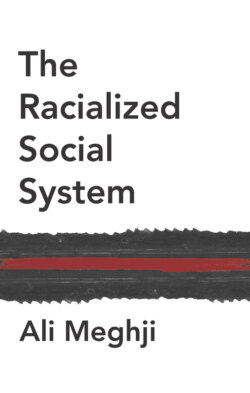Читать книгу The Racialized Social System - Ali Meghji - Страница 14
Internationalizing CRT: looking for the racialized social system approach
ОглавлениеWhile the racialized social system approach seems to offer a set of useful tools that can be put to the trial of empirical research, it has almost been left behind as other dimensions of CRT have expanded across and outside of US geographical borders. Indeed, just as CRT was taking off in American law and education studies, where it was predominantly focused on a white–Black axis, other racially minoritized groups in the US used this foundational work to explore the educational and legal experiences of Latinos (which gave rise to ‘LatCrit’),37 South Asian Americans (which gave rise to ‘DesiCrit’)38 and indigenous Americans (which gave rise to ‘TribalCrit’).39 This early US-centricity of CRT led to some early charges of methodological nationalism, with scholars such as Goldberg and Essed (2002: 4–5) arguing that CRT is:
unfortunately marked by an American parochialism, with being caught up with the more or less restricted considerations of legal structures, conditions, and rationalities in the US context. Scant attention is paid either to the applicability and implications of its key concepts outside of that context, or perhaps more importantly […] to thinking its central concepts through their globalizing significance and circulation.
The wider international community then answered this call to think through American CRT’s ‘central concepts through their globalizing significance and circulation’. However, even as CRT expanded beyond the US borders, this scholarship remained rooted in the first ‘two waves’ rather than engaging with the racialized social system approach. In Europe, for instance, the majority of CRT scholarship seemed to go one of two ways.
Firstly, there emerged a wave of scholarship which looked at how legal systems across the European continent – despite the pretence of being against discrimination – reproduced structural racism; this scholarship was very much informed by American critique of civil rights legal reform. Thus, scholars such as Möschel (2011) point out that post-war European anti-discrimination law has largely gone down the route of equating anti-racialism (arguing that we should not use racial terms) with anti-racism (actions to dismantle racism); preamble No. 6 to the European Racial Equality Directive (ERED), Directive 2000/43/EC, for instance, holds that ‘the European Union rejects theories which attempt to determine the existence of separate human races. The use of the term “racial origin” in this Directive does not imply an acceptance of such theories.’40 In response to this ERED, countries across Europe such as Italy, Austria, Germany and France have all avoided using ‘race’ in national legal frameworks, favouring notions of citizenship, nationality or ‘ethnic belonging’, consequently making it extremely difficult to actually unearth dimensions of racial inequality.
Secondly, there was a wave of scholarship, mostly located in Britain, which looked at structural racism in the education system – this movement has been termed ‘BritCrit’.41 Such scholarship engaged a great deal with the US education CRT scholarship, but again took no notice of the racialized social system approach. Thus, as Gillborn (2011) argues, CRT’s inception in the UK was beneficial because it created a context where British racism could be taken as a starting point for analysis in education, rather than as something that had to be proved. BritCrits thus produced invaluable evidence of racial inequality in the British education system, from means testing (Gillborn 2010), through to academic hiring (Rollock 2021) and stigmatizing pupils (Rollock et al. 2015), all of which challenged the dominant colour-blind rhetoric which was being enforced across the British schooling system. However, the majority of this BritCrit scholarship adopted Delgado and Stefancic’s tenets of CRT, and did not think about how Bonilla-Silva’s racialized social systems approach could be useful for social analysis. In co-edited books and review articles focusing on CRT in Britain, such as Atlantic Crossings: International Dialogues on Critical Race Theory (Hylton et al. 2011), Warmington’s (2020) ‘Critical race theory in England: Impact and opposition’ and Gillborn’s (2006b) ‘Critical race theory beyond North America: Toward a trans-Atlantic dialogue on racism and antiracism in educational theory and praxis’, we therefore see no mention of the racialized social system approach.
Central to this book’s mission, therefore, is to bring some wider international visibility to the racialized social system approach, and to how it is an effective theory for thinking about racialization and racism in different temporal and spatial locations. The aim is not to attempt any universalization of the racialized social system approach, but rather to show how it enables us to think critically about racism and its articulation across the micro, meso and macro levels. In order to do this, I have divided the book as follows.
